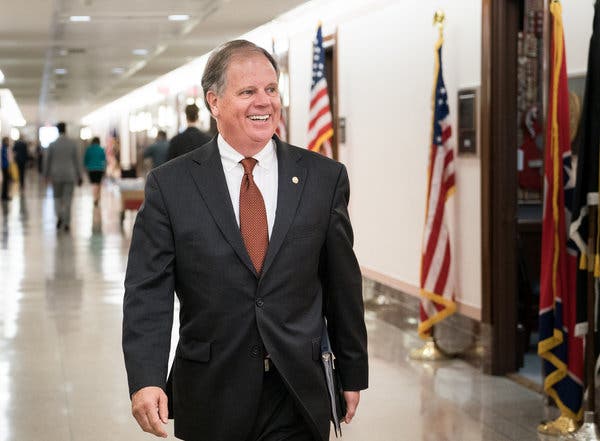Advertisement
Poll Watch
Republican incumbents in swing states have struggled to disentangle themselves from President Trump, whose voters are loyal but represent a minority of the electorate.

Welcome to Poll Watch, our weekly look at polling data and survey research on the candidates, voters and issues that will shape the 2020 election.
A driving theme of Republican Party politics circa 2020 is consolidation.
The G.O.P. has tightened its ranks; its reliable voters, hovering at around 40 percent of the electorate, tend to approve of almost anything President Trump does.
Yet throughout his term, from the 2017 battles over health care and tax cuts to his impeachment and subsequent acquittal early this year, very few people from outside the party have been coming aboard.
Mr. Trump has led the charge, but his effects are being felt far down the ballot. Two years after Democrats swept the midterm House elections by a historically wide margin and with historically high turnout, polling suggests they have a shot at a similar showing this year.
And in the high-stakes Senate, G.O.P. incumbents in swing states have struggled to disentangle their numbers from Mr. Trump’s stubbornly minoritarian status. That is putting Democrats in a strong position as they look to take back the Senate in the midst of a pandemic.
“The Republican brand seems depressed across the board,” Simon Rosenberg, a Democratic strategist and founder of the New Democrat Network, said in an interview. “A lot of time senators can insulate themselves from the vagaries of the national electorate, but that doesn’t seem to be happening this time.”
A net loss of four Senate seats — or three, plus the vice presidency — would hand the chamber to the Democrats, and Republicans this year must defend almost twice as many seats as their opponents. And G.O.P. incumbents in many swing states are looking at a hard battle if they cannot expand beyond the taut Trump coalition.
That includes candidates in some states, like Arizona and Georgia, that have trended more Democratic of late but have still voted Republican in every presidential election since the 1990s.
“The Senate majority has not been a certainty at any point this cycle,” Mitch McConnell, the Senate majority leader, acknowledged during an interview last month with Fox News Radio. “I’ve said consistently that it’s going to be a dogfight.”
The Senate is of vital importance to Republicans, no matter who takes the White House. Before the coronavirus pandemic hit, it had been the lab of the G.O.P.’s major political pursuit these days: confirming the president’s conservative appointees to federal judgeships. Even amid the virus’s spread, Mr. McConnell was eager to bring the chamber back into session to continue confirming judges and federal appointees.
And if Joseph R. Biden Jr. wins the presidency, the Senate would most likely be the only backstop against full Democratic control of the executive and legislative branches.
Mr. Trump has shifted the Republican coalition toward male voters and less educated ones. At the same time, the party’s advantage among older voters has all but disappeared.
Those trends have played out in various statewide races since 2016, and they are likely to repeat themselves in the battle for the Senate this year.
In the 2014 midterms, for instance, college graduates supported Republicans by three percentage points, according to exit polls. By 2018, they had swung widely in the Democrats’ favor, supporting them by 20 points. In that time span, the Republicans’ advantage among voters 65 and over dropped from 16 points to two points.
In Arizona, this year’s Democratic Senate candidate, Mark Kelly, held a three-point edge over the Republican incumbent, Senator Martha McSally, in a Marist College poll this spring, and among independent women he was ahead by 20 points.
To the north, in Colorado and Montana, Democratic governors have entered the race for Senate. Polls in Colorado have shown a remarkable parity between voters’ support for Mr. Trump and for Senator Cory Gardner, the Republican incumbent; at the moment, both appear to be trailing by double digits.
Two Republican senators in politically mixed states — Susan Collins of Maine and Joni Ernst of Iowa — have seen dips in their approval ratings since they voted to acquit Mr. Trump on impeachment charges, and they are both locked in close races.
Two Senate seats are up for grabs in Georgia after the resignation of Senator Johnny Isakson last year created a vacancy. An increase in voters of color, particularly African-Americans, has combined with a softening of Republican support in the suburbs to create a new opportunity for Democrats.
In North Carolina, which has voted Democratic for president just once since the 1970s, surveys show that the race between Mr. Trump and Mr. Biden is up for grabs. The race for the state’s open Senate seat, held by the Republican Thom Tillis, is equally tight.
The Democrats’ most threatened incumbent this year is Senator Doug Jones of Alabama, who won an upset victory in a 2017 special election against the scandal-plagued Republican former judge Roy Moore. A Mason-Dixon poll in February found Mr. Jones trailing a range of potential Republican nominees, but most of them by single digits.
Thirty-four states elected senators in 2016, and in each case, their choice for Senate lined up with their pick for president. Political persuasions have hardened significantly in recent years, partly a result of an increasingly polarized media landscape and online consumption habits.
Lee Miringoff, who runs Marist’s polling institute, said the starkly partisan nature of Trump-era politics had changed the way elections must be fought.
“We’re so polarized that there’s no trade-offs going on, there’s no persuasion, so it’s all about the turnout and the enthusiasm,” he said.
In this regard, Mr. Trump and Republicans see room for hope. In key early-voting states this primary season, Republican turnout was strikingly high, considering that the party’s presidential nomination is uncontested this year. And G.O.P. voters remain more motivated to vote in November than most Democrats, according to recent polls — though that trend could reverse itself as Mr. Biden amps up his campaign in the summer and fall.
The registered electorate leans more Republican than the general population by a few points, and the Electoral College adds to the Republican tilt by increasing the influence of rural states. In the days leading up to President George W. Bush’s re-election in 2004, approval of his job performance was split, 48-47 percent, among all Americans, according to Gallup, but Mr. Bush went on to win by a two-point margin. Republicans also outpaced Democrats by two points in House elections nationwide that year.
In 2012, President Barack Obama beat Mitt Romney by four points, shy of his seven-point Gallup net approval rating just before the election, more evidence of the electorate’s crimson tint.
This year, Republicans are looking to a similar calculus: Mr. Trump’s approval rating has yet to hit 50 percent in most major polls — a first in modern history — but it has generally remained in the 40s. If he finishes the campaign strong, he could feasibly eke out a win despite minority approval, as Mr. Bush did in 2004.
That would most likely provide some coattails to Republicans running for the Senate, given the lack of variation in people’s voting habits nowadays.
There is another complicating factor that could play to Republicans’ favor: The very process of voting during a pandemic is different from voting in normal times.
While the electorate always skews a little bit more affluent and white than the population as a whole, access to the ballot may be particularly limited for voters in urban areas hit hard by Covid-19, and in areas with large populations of people of color who are disproportionately affected by Republican efforts to limit access to the ballot.
“There’s an open question about what kind of electorate you’re going to be seeing in the fall,” Kyle Kondik, the managing editor of Sabato’s Crystal Ball at the University of Virginia Center for Politics, said in an interview. “Many of us prior to the public health crisis were expecting a turnout probably higher than 2016, at least in a lot of places. Interest in politics was high, the midterm elections had a historically high turnout.”
All of that has been scrambled now, as demonstrated by the experience of Wisconsin’s fractious elections in April, when all of Milwaukee was left with just five polling places serving a city of 600,000.
“How easy will it be to vote in the midst of the pandemic?” Mr. Kondik said. “We don’t know what the situation is going to be in November.”


